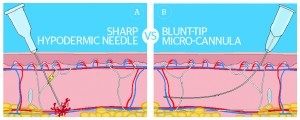Aesthetic medicine and everything connected with it is growing at a rapid pace. Needles for injection procedures are no exception, and particularly with regard to cannulae. Cannulae are effectively blunt needles with an aperture on the side, referred to as ‘side port’. The emergence of cannulae in aesthetic medicine has given a new impetus for injection procedures. It offers increased efficiency — especially with large volumes — more comfort during treatments, reduced side-effects (e.g. less pain, less swelling, fewer cases of haematoma), and a shorter after-procedure recovery period1–8. Initially, cannulae had been used for the injection of soft tissue fillers only; however, more recently, they have also been used for the administration of non-cross-linked hyaluronic acid (HA) and platelet-rich plasma (PRP)9,10.
As opposed to a needle, administration into different treatment areas using a cannula can be performed through a single access point, and the extended length of a cannula allows for the selection of the safest incision area. The cannula can bend around tissue structures and push away blood vessels and nerves, where a needle would otherwise simply pass through (Figure 1).
This less traumatic injection approach of gliding through the tissue, rather than penetration, can reduce pain and shorten recovery time, making the procedure more comfortable for the patient. Furthermore, blunt cannulae help to reduce the risks of intravenous and/or arterial embolism, enhancing patient safety8,11–15. Using cannulae requires less extrusion force, meaning the product should be injected into tissues at a lower pressure, which plays a significant role in abating procedure-related pain.

Figure 1 Penetration of a sharp needle (A) and microcannula (B) through tissue structures. Image A illustrates how a sharp needle pierces a blood vessel, while image B shows a blunt-tip microcannula that bends around a vessel
It is no surprise, then, that there is a vast range of cannulae available on the market, with different manufacturers producing a variety of models and modifications. Therefore, it is important to understand the advantages and disadvantages with regard to different treatment areas. The aim of this article was to review the most widely used cannulae and share the author’s personal findings on the most reliable and effective models, complemented by the existing research of recognisable industry professionals. It must be emphasised that the author does not claim that his findings and recommendations are the only available option, but shares his personal experience and invites others to do so.
The reviewed cannulae presented in this article come in a variety of gauges and lengths (30, 27, 26, 25, 22 G, and 19–70 mm). The manufacturers considered are:
- Aesthetic Group (INEX); Puiseux le Hauberger, France
- SoftFil; Paris, France
- Sterimedix; Redditch, UK
- Magic Needle; Paris, France
- Mesotech Srl; Arzano, Italy
- TSK Laboratory; Tochigi-Ken, Japan.
The cannulae were tested during rejuvenation procedures on the face, neck, décolleté, and hand areas, using non-cross-linked HA and/or PRP.
As the demand for cannulae grows, the product offerings are increasing and upgrades are being rapidly developed. When selecting a cannula, the following criteria should be considered:
- Reliability
- Flexibility
- Ease of administration
- Required length
- Required effort while injecting the product
- Purchase availability
- Reasonable price
- Product range
- Approval by official agencies.



